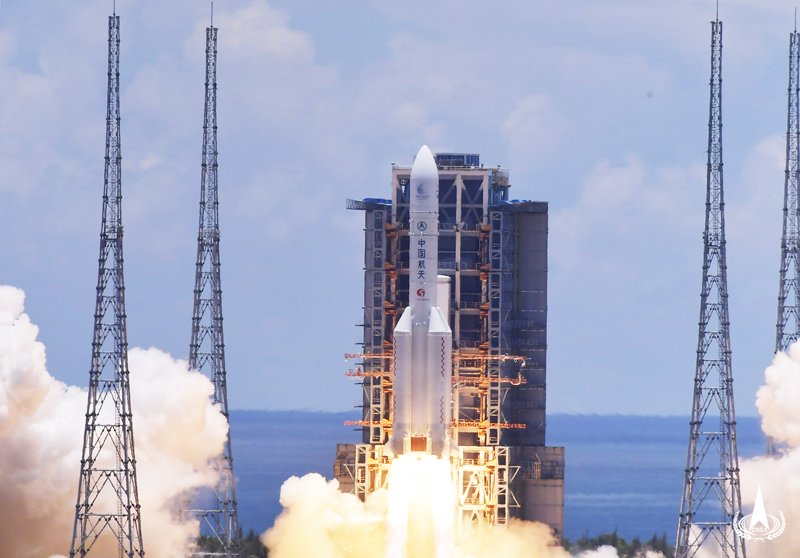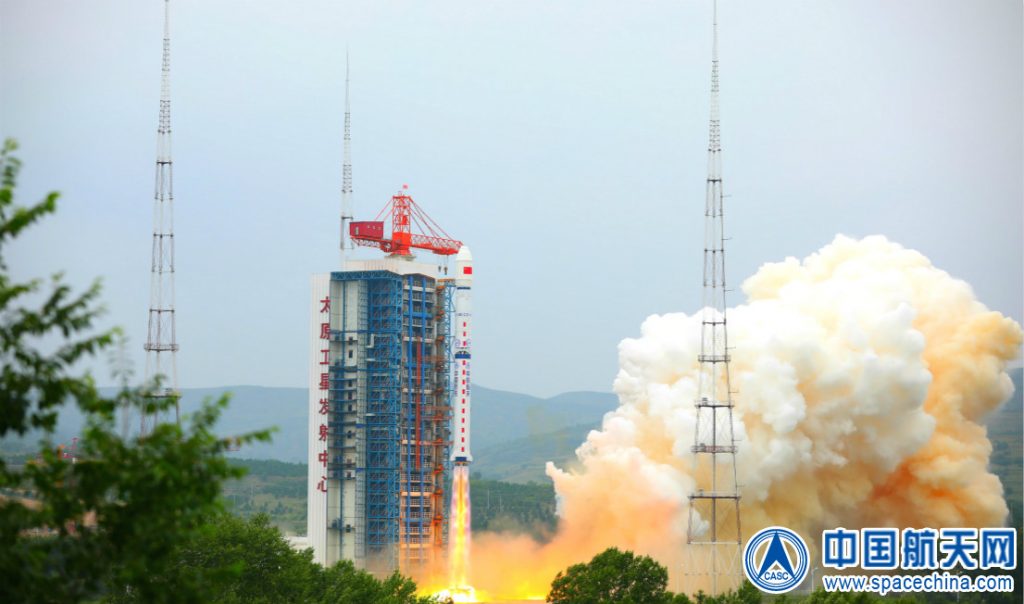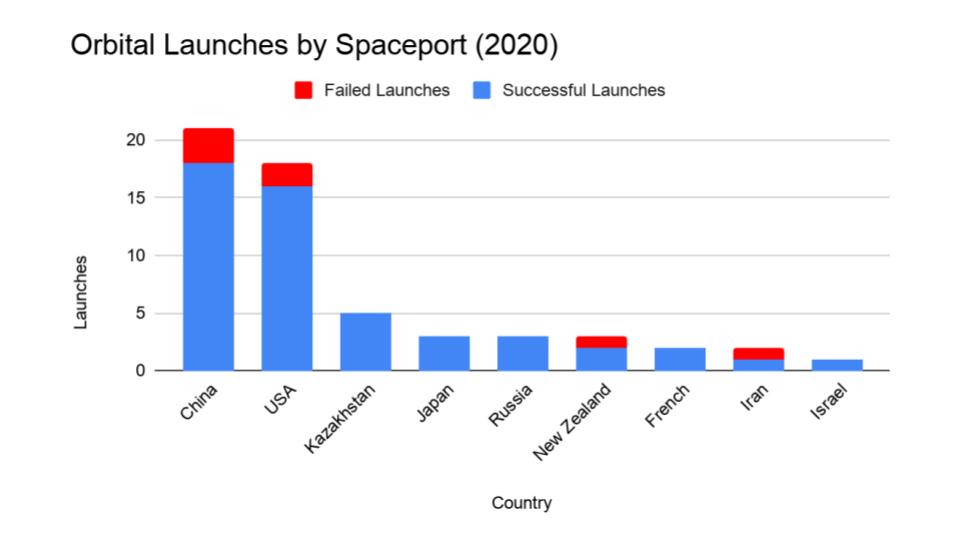Media
Transcript
First up, at 4:41 AM UTC, a Long March 5 rocket blasted off from Wenchang Space Launch Center, sending the Tianwen-1 on its way to Mars. It’s expected to arrive next February.

The mission consists of an orbiter, lander, and rover. According to Xinhua News Agency, China’s official state-run press agency, the mission name Tianwen can be translated as “Heavenly Questions” or “Questions to Heaven” and was inspired by a long poem of the same name by Qu Yuan, who lived from about 340 BC to 278 BC. In the poem, the author “raised a series of questions in verse involving the sky, stars, natural phenomena, and the world, showing his doubts about some traditional concepts and the spirit of seeking the truth.”
The orbiter and rover each have several instruments, some of which will use radar to look for water-ice hidden just beneath the surface of the red planet. A few other mission objectives include gathering data on Martian climate, geology, and magnetic fields.
A Roscosmos Soyuz-2 rocket launched the Progress MS-15 (76P) mission on July 23 at 2:26 PM (UTC) from LC-31/6 at the Baikonur Cosmodrome in Kazakhstan.

MS-15 is a resupply mission to provide the International Space Station (ISS) crew with supplies and consumables. Among the cargo is a new piece of equipment that will help trace the source of elevated benzene levels in the space station’s air. A NASA spokesperson said that there is already additional air filtering in place, and so far, all detected levels have remained well below the threshold where it would impact the crew.
Other items of note include some new shoes for one of the NASA crew members, solid and liquid waste containers for the toilets, a pretreat tank for the water recycling system in the Russian segment of the station, along with two months’ worth of food.
Docking with the ISS was done using the KURS-NA automated docking system. It was a bit more exciting than usual as a software issue caused Progress to deviate from the flight plan and go off-course. Russian controllers and crew did not hit the abort button, and the docking took place once things were resolved.
Finally, on July 25 at 3:13 AM (UTC), a Chinese Long March 4B rocket launched three satellites from LC-9 at Taiyuan Satellite Launch Center.

The biggest payload — weighing in at 2650 kilograms (1325 two-liter soda bottles) — was the Ziyuan-3 03 satellite, which will join the other two Ziyuan satellites in orbit. This is China’s first constellation of high-resolution mapping satellites for civilian use. Until the Ziyuan satellites were launched, China was using other countries’ satellites to collect data for mapping and surveying. The Chinese enthusiast blog SpaceFlightFans reports that this constellation has saved the country hundreds of millions of dollars. A fourth satellite to complete the constellation is planned to launch later this year.
The co-passengers for this flight were Tianqi 10 and Lobster Eye X-ray Exploration Satellite.
Tianqi 10 is the seventh addition to the Tianqi constellation, which provides “much-needed data collection and transmission services for terrestrial network coverage blind areas,” according to Gunter’s Space Page.
Lobster Eye 1 is a joint project between Nanjing University, the University of Hong Kong, and China Aerospace Science and Technology Corporation (CAST). The name refers to an optical principle described in the scientific literature back in 1979 where an instrument constructed similarly to that of a lobster’s eye could observe a large field of view with a minimum of components, an ideal combination for space-based astronomy (large field of view, low weight, and complexity).
Lobster Eye 1 is designed to observe large areas of the sky simultaneously in the soft X-ray part of the electromagnetic spectrum, unlike NASA’s Chandra Observatory that observes in the “hard” X-ray portion of the spectrum. “Soft” X-rays are higher in energy than ultraviolet, but much less energetic than the “hard” X-rays used for things like chest X-rays or bone scans. Earth’s atmosphere blocks soft X-rays, so it’s not possible to observe them from the ground. Some of the science to be done using the Lobster Eye includes X-ray detection and location as well as possible dark matter verification.
BONUS FACT: Soft X-rays are routinely used for medical imaging of fine structures and were the means by which DNA was discovered.
The optics also allow for a wide range of wavelengths to be observed and does so in a way that detects and measures changes in the image over short periods of time, neither of which are practical or possible for hard X-ray detectors like NASA’s Chandra X-ray Observatory.
Twelve minutes after launch, what appears to be the first stage of the rocket crashed down in the mountainside in Yunyang district of Shiyan city, Hubei.
According to Shiyan Evening News, “the landing of the wreckage caused no casualties or economic losses. The local armed forces and public security departments protected the site, and the relevant departments have processed the wreckage.”
To wrap things up, here’s a running tally of a few spaceflight statistics for the current year:
Toilets currently in space: 4
Toilets burned up: 2
Total satellites humans put into orbit: 560 (includes those launched from other in-orbit craft, such as the ISS)
Total satellites from launches: 544
Total 2020 launch attempts: 55 (including 7 failures)
I keep track of orbital launches by where they launched from, also known as spaceport. Here’s that breakdown:

China: 21
USA: 18
Kazakhstan: 5
Japan: 3
Russia: 3
New Zealand: 3
French Guiana: 2
Iran: 2
Israel: 1
Your useless space fact for the week comes to us from community member refsmatt, who shares that on Apollo 16, John Young complained over a hot mic about how gassy he was from the potassium-fortified orange juice that the astronauts were required to consume.
Learn More
China’s first Mars exploration mission probe successfully launched
- China National Space Administration news release (Chinese)
- Xinhua News Agency article (Chinese)
- China seeks “Heavenly Questions” with ambitious Tianwen-1 mission to Mars (NASASpaceflight.com)
Progress MS-15 arrives at Station with eventful automated docking
- Roscosmos launch news release
- Progress MS-15 arrives at Station with eventful automated docking (NASASpaceflight.com)
China launches new high-resolution mapping satellite
- China National Space Administration news release (Chinese)
- Xinhua News Agency article (Chinese)
- Launch of the world’s first soft X-ray satellite with ‘Lobster-Eye’ imaging technology (phys.org)
- Tianqi 10 (Gunter’s Space Page)
Credits
Host: Annie Wilson
Writers: Annie Wilson, Dave Ballard, Gordon Dewis, Ally Pelphrey
Audio and Video Editing: Ally Pelphrey
Content Editing by Beth Johnson
Executive Producer: Pamela Gay
Intro and Outro music by Kevin MacLeod, https://incompetech.com/music/


 We record most shows live, on Twitch. Follow us today to get alerts when we go live.
We record most shows live, on Twitch. Follow us today to get alerts when we go live.